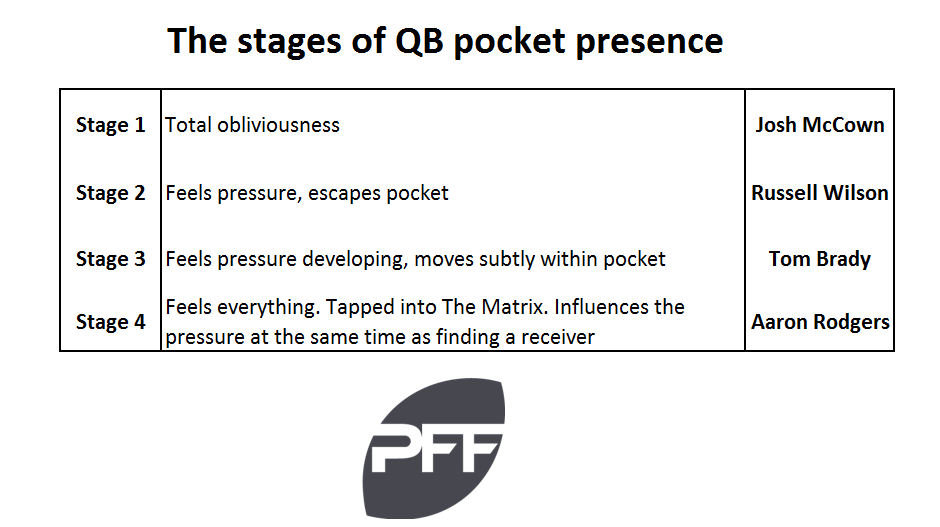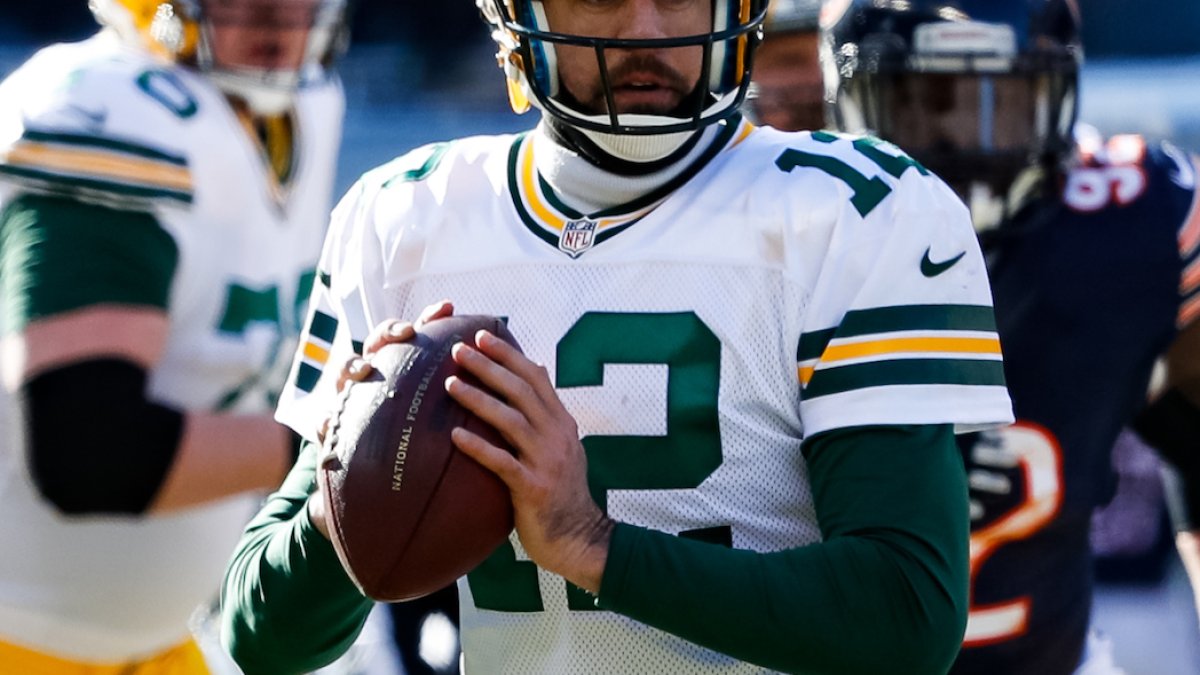It seems hard to believe that it isn’t long ago we were all asking what was wrong with Aaron Rodgers and the Green Bay offense.
After six weeks of this season Rodgers was the league’s No. 29 QB in PFF grades, below Denver's Trevor Siemian, among many others. He still didn’t seem comfortable within the Packers offense, despite arguably the league’s best pass protection working to keep him clean, and we were questioning what needed to change for Rodgers to rediscover the play that made him the game’s best QB in previous seasons.
Since that point in the season, however, Rodgers has been the league’s best-graded QB, and the only one who has been able to rival the play of Tom Brady overall. He has dragged himself up to the No. 4 spot in PFF grades among QBs at 91.9, just fractions behind Andrew Luck and Matt Ryan over the full season, with Brady some distance out in front. We have seen Rodgers back to his best.
As recently as late November, the Packers were in deep trouble. They sat at 4-6, two games back from both the Detroit Lions and Minnesota Vikings in the division. Now after a five-game win streak they have closed that gap, are tied with the Lions at 9-6 atop the division, and would be in a “win-and-in” scenario even without the Week 17 opponent being Detroit, thanks to tiebreakers.
From being a team looking listless and without a chance of resurrection, they are now one of the league’s hottest teams and an opponent nobody wants to draw in the playoffs.
That has been down entirely to the offense, and mostly down to Rodgers, who has rediscovered his comfort level on the field and is doing things that other QBs simply cannot and do not do.
Aaron Rodgers on his game is basically impossible to defend. Even if you're half trying to contain he'll just escape and score anyway: pic.twitter.com/azpBRNAyZa
— Sam Monson (@PFF_Sam) December 29, 2016
The Lions' season depends on figuring out a way to defend Rodgers in a way they couldn’t manage earlier in the season, even with Rodgers in the midst of his funk, and against a player who at his best might be impossible to defend. The first time the two teams met, Green Bay was able to put up 34 points, and while Rodgers only passed for 205 yards, he threw four touchdown passes and had a passer rating of 146.1 when kept clean in the pocket.
The average QB in the NFL sees a 33.8-point drop in passer rating when pressured, but Rodgers this season still has a passer rating of 90.8 when pressured (a drop of 16.9 points), and over the past four weeks his passer rating actually goes up by 12.4 points when heat is applied. At that point, you’re effectively relying on actually sacking him to prevent him making plays, and that isn’t going to happen often enough to form the foundation of a game plan.
Rodgers' relationship with pressure is one of the most interesting aspects of his game. Pocket presence is something that gets thrown around as a universal term, but it isn’t a binary state, with QBs either having it or being without.  Pocket presence can almost be seen as a progression through martial arts. White belt quarterbacks feel nothing at all in the pocket. Their attention is consumed downfield on receivers and coverage and every time pressure arrives, it takes them by surprise.
Pocket presence can almost be seen as a progression through martial arts. White belt quarterbacks feel nothing at all in the pocket. Their attention is consumed downfield on receivers and coverage and every time pressure arrives, it takes them by surprise.
Crazy as it seems, QBs can still make it to the NFL with white belt levels of pocket presence, and some go through their entire careers at that level, with a total and complete obliviousness to what’s developing around them. If you get a lucky-enough run, you can even play well with that blissful ignorance of how close you just came to disaster on the play.
The next stage of pocket presence is QBs who feel pressure developing and take off from the pocket when it comes, potentially turning sacks into positive plays by scrambling, buying time for a pass or just getting to a point where they can throw the ball away. This is blue or purple belt levels of pocket presence, depending upon how good the QB is at it. It’s obviously more useful than not feeling anything, and it can lead to some huge plays, but it’s limited in how effective it can be over the long term. Colin Kaepernick has this kind of pocket presence, and when he takes off he can hurt teams, but his effectiveness is limited if he is contained within the pocket. Russell Wilson also has this type of pocket presence, but he is far more dangerous in almost all facets of the game than Kaepernick.
Then we get to the more advanced levels of pocket presence. Our brown or black belts are the guys who not only feel the pressure, but are able to anticipate it a little earlier in the process, and instead of taking off to escape it, can make subtle movements in the pocket to ease away from it without completely detonating the leverage of everybody trying to pass block. This is where the Tom Bradys and the Peyton Mannings of the NFL reside. It’s extremely high-level stuff, and it means that pressure has to be dominant to really make an impact. Just squeezing the pocket doesn’t have the same effect on these QBs as it would against the lower-ranked pocket-presence belts, because they can adjust and make plays as if the pocket were clean. Even if they sense pressure coming that will blow up the play, they feel it coming soon enough that it rarely ends in a sack. These QBs typically have a very low sack rate compared with the rate at which they are pressured.
They aren’t, however, the pinnacle. Above even the black belts of pocket presence lies something else, and this is where Aaron Rodgers resides. Rodgers is our mythical ninja of pocket presence — he’s the Rickson Gracie. He doesn’t just sense pressure developing and neutralize it with subtle movements within the pocket like the brown and black belts, but he is actively influencing the pressure with his movements by effectively resetting the leverage of his blockers back and forth as he adjusts in the pocket and forces pass-rushers to match him or lose contain.
And if you REALLY set out to contain him, he'll dance like a pocket-manipulating ninja, THEN take off and hurt you anyway pic.twitter.com/RyxHA6s7dO
— Sam Monson (@PFF_Sam) December 29, 2016
On these plays it looks like Rodgers is tapped into The Matrix. He feels everything at once, in slow motion, and is able to influence the pass rush and his protection, all at the same time as actually reading the defense and finding an open receiver. Simply put, it’s freaky, and while other QBs might be able to play better overall, I’m not sure any are capable of the same kind of thing Rodgers is from a pocket management standpoint.
Obviously, Rodgers has the abilities of all of the previous stages of pocket presence, too, and at some point, the pressure is so severe there is no option but to bail and escape it, but there are plays where other QBs would find themselves hurried forced to move enough to collapse the pocket, but Rodgers can just continue to bounce back and forth in equilibrium within the pocket and perpetually keep the pass rush from having a clean angle to attack him.
While it’s true that Green Bay’s pass protection has been exceptional this season, I think that they also benefit at times from this ability Rodgers has to reset their leverage when they are in danger of allowing a defender to influence the pocket. Typically, the longer a QB holds the ball, the worse things are for his blockers, and a QB that moves around is a nightmare for a blocker to deal with, because he doesn’t know where he is going to be at any given moment, but with Rodgers there is some give to go along with that take.
Part of what allows him to have this effect on pass-rushers is that he has shown for years he is a legitimate threat to make plays with his legs, or make even bigger plays with his arm, after escaping the pocket. Teams only have so much fear of what Brady can do to them in the open field if they flush him from the pocket, but that takes on a whole new level with Rodgers. He could turn man coverage into a huge gain on the ground by running at defenders with their backs turned to him, or he can flick the ball effortlessly 50 yards downfield when the coverage breaks down. Teams want to keep him in the pocket, so they can’t sell out to rush and vacate their lanes, and every time he makes a move, they have to counter it.
Herein lies the problem for the Detroit defense. In any normal instance, you want to get after a QB as much as possible to pressure him into mistakes. As noted earlier, league-wide that takes a QB’s passer rating down more than 30 points. Even if you don’t actually get him to the ground, statistically speaking you turn Tom Brady into Trevor Siemian simply by applying pressure. Last week, the Eagles pressures Eli Manning 21 times, and while they never managed to sack him, Manning’s passer rating fell almost 70 points to 10.7 on those plays. They forced him into two interceptions and he completed passes for just 57 yards when hurried.
Rodgers is both harder to pressure, and not affected the same way as other QBs when he is. The Lions, like most teams, will be trying to keep him bottled up in the pocket, but that gives him the platform to just work the pocket like no other QB and kill them anyway.
Right now, Aaron Rodgers may be the league’s most difficult puzzle to solve, and it’s one Detroit needs to work out if they want to be playing football come the postseason.



 © 2024 PFF - all rights reserved.
© 2024 PFF - all rights reserved.